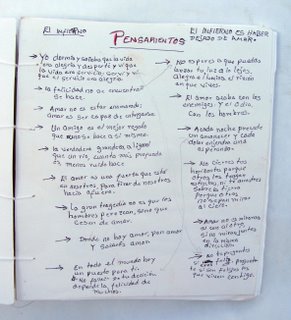shared thoughts, Hurricane Stan

From January to March of this year teenagers, adults, and kids in my painting workshops were given the opportunity to express their experiences and thoughts with regard to Hurricane Stan, which hit the region during the first few days of October, 2005. In the municipality of Tacaná, 144 communities were affected; 84 people died or disappeared, 1,610 houses were destroyed or rendered unlivable, and 9,000 people were left homeless.

The drawings show us dark skies with heavy rain, dirty rivers filled with fallen trees, landslides, houses buried in earth, people toting their belongings and abandoning their houses, women praying, children crying, and more.

On one page the author writes us a small story, “EL NIÑO QUE VIO QUE NADIE VIO,” or THE BOY THAT SAW WHAT NO ONE SAW. In a family there was a señorita who was sad because the rain continued. It had been three days that she hadn’t seen her boyfriend. And a teenager who wondered how it was going to be after the storm. And a little boy who looked out the window. The mom felt that he was sad and went to console him and the little boy said, “Look, mama, how pretty the rainbow that Hurricane Stan came to bring us.”

In another, titled “Pensamientos,” or Thoughts, the 28-year-old author from Linda Vista writes 16 ideas he wishes to share about the Hurricane and life in general. In one workshop we developed a conversation about service and solidarity by using this page to provoke our discussion.
I slept and dreamed that life was happiness, and I woke up and saw that life was service, I served and saw that life was happiness.
To love is not to look at one another, but to look together in the same direction.
Don’t wait until you can spread your light far away. Be happy and illuminate the corner in which you live.
In spite of the destruction the communities have demonstrated faith and hope, which has helped them continue moving forward to reconstruct what was lost. Their histories are inspiring and show us the necessity to continue fighting for better lives and to learn to be prepared for future storms and natural catastrophes.
The book was left with la JEM to share with visitors and to keep as a record of the stories, horrors, and courage of their people. Twenty blank pages were included in the back of the book in order to allow more participants to share their experiences.

0 Comments:
Post a Comment
<< Home